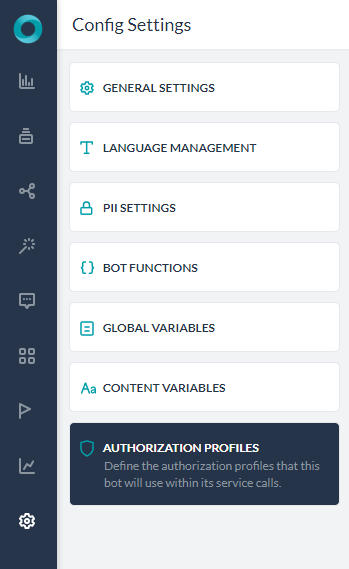API 키는 식별 및 권한 부여를 위한 고유 식별자 및 시크릿 토큰 역할을 하여 연결된 API에 대한 일련의 액세스 권한을 제공할 수 있습니다. 최종 사용자에게 액세스를 위한 사용자 이름 및 암호를 묻는 대신 봇을 설정할 때 API 키만 묻는 메시지가 표시됩니다. API 키 권한 부여 유형을 사용하려면 먼저 애플리케이션에 계정을 등록한 다음 애플리케이션의 API 키를 생성하여 Kore.ai 권한 부여 메커니즘을 위한 설정을 구성합니다. 봇에 권한 부여를 정의하려면, 다음 단계를 따릅니다.
테넌시 정의
필요한 경우 하위 도메인 섹션에서 웹 애플리케이션 또는 사용자 인터페이스의 기본 URL이 URL의 테넌트 이름을 사용하는 경우 예를 선택합니다. 예를 들어, kore는 테넌트를 www.kore.somCompany.com에서 사용하는 웹 서비스의 테넌트 조직입니다.
권한 부여 필드 추가
기본적으로 권한 부여 필드는 봇 요청 메시지의 헤더 일부로 구성됩니다. 봇 요청에 추가 권한 부여 필드가 필요하거나 예상되는 권한 부여(예: 사회 보장 번호 또는 PIN)가 헤더의 일부가 아닌 경우 권한 부여 필드 섹션에서 추가를 클릭한 후 다음 그림과 같이 필드를 정의합니다.
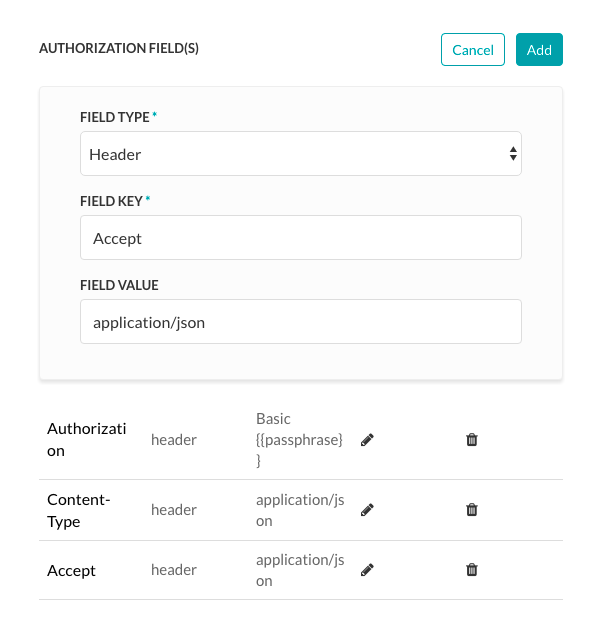
- 필드 유형 필드에서 봇 요청 메시지 및 필요한 권한 부여 필드 유형에서 위치에 따라 다음 중 하나를 선택할 수 있습니다.
- 헤더 – 봇은 요청 헤더의 일부로 권한 부여 필드를 예상합니다.
- 페이로드 – 봇은 요청 본문 내용의 일부로 권한 부여 필드를 예상합니다.
- 쿼리 문자열 – 봇은 요청 본문에서 권한 부여 필드를 쿼리로 예상합니다.
- 경로 매개 변수 – 봇은 권한 부여 필드를 요청의 URL 경로의 일부로 예상합니다.
- 필드 키 필드에서 선택한 필드 유형에 대한 필드 이름을 입력합니다.
- 필드 값 필드에 지정된 필드 키의 값을 입력합니다.
- 추가를 클릭합니다. 새 권한 부여 필드가 권한 부여 필드 섹션에 추가됩니다.
추가 인증 권한 필드를 추가하려면 권한 부여 필드 섹션에서 추가를 클릭합니다.
IDP 양식 필드 추가
기본 사용자 이름과 암호 필드가 요구 사항을 충족하지 않는 경우 권한 부여 IDP 양식 필드를 추가하여 최종 사용자에게 표시할 새 필드를 추가할 수 있습니다. 권한 부여 양식에 필드를 추가하려면 IDP 양식 필드 섹션에서 추가를 클릭합니다. 다음 표에서는 권한 부여 IDP 양식 필드를 정의하는 데 사용되는 필드를 설명합니다.
| 필드 이름 | 설명 |
|---|---|
| 필드 제목 | 인증 대화 상자에서 최종 사용자에게 표시되는 필드 이름을 지정합니다. |
| 필드 키 | 이 값은 인증 서비스에 대한 최종 사용자 입력을 나타냅니다. |
| 도움말 힌트 | 필드에 표시되는 도움말 텍스트로서 필드에 입력해야 하는 내용을 설명합니다. |
| 필드 유형 |
고급 옵션을 선택하면 최종 사용자 인터페이스에서 표시되는 필드의 유형을 지정하여 다음 중 하나의 필드 키 값으로 할당된 사용자 입력을 수집합니다.
|
| 필수 | 고급 옵션을 선택하면 최종 사용자가 인증을 완료하려면 이 필드를 정의해야 하는지 여부를 선택합니다. |
| 데이터 유형 | 고급 옵션을 선택하면 최종 사용자의 입력으로 예상되는 데이터 유형(예: 문자열)을 지정합니다. |
| 가시성 | 고급 옵션을 선택하면 인증 필드의 속성을 표시, 숨김 또는 읽기 전용으로 표시할지 여부를 지정합니다. |
권한 부여 확인 URL
권한 부여 확인 URL 필드에서 권한 부여 메커니즘으로 봇을 배포하기 전에 봇 빌더에서 인증 설정 테스트에 사용할 수 있는 URL을 선택적으로 정의하세요. 동적 필드와 경로 매개 변수 필드, 쿼리 필드 등을 사용하여 URL 테스트를 정의할 수 있습니다. 예: https://kore.someCompany.com/sap/opu/odata/sap/{{authfield1}}/?$format=json
커넥터를 사용한 액세스
커넥터를 사용한 액세스 섹션에서 Kore.ai 커넥터 에이전트를 사용하여 Kore.ai 봇의 액세스를 활성화하려면 예를 선택합니다. 도메인에 활성 Kore.ai 커넥터가 정의되지 않으면 봇 관리자 콘솔 시스템 관리자에게 문의하라는 경고 메시지가 표시됩니다. 자세한 내용은 봇 관리 콘솔 설명서에서 Kore.ai 커넥터 사용을 참조하세요. 저장을 클릭하여 권한 부여 설정을 저장하고 새 권한 부여 메커니즘 대화 상자를 닫습니다.
권한 부여 테스트
인증을 저장한 후 권한 부여 프로필 페이지에서 테스트를 클릭하면 권한 부여 정의를 테스트할 수 있습니다. 테스트를 클릭하면, 권한 부여 테스트 대화창이 나타납니다.  API 키를 사용한 권한 부여 테스트 설정 방법
API 키를 사용한 권한 부여 테스트 설정 방법
- 권한 부여 확인 URL 필드에서 인증 설정을 테스트하려는 URL을 확인하거나 입력합니다.
- 봇이 하위 도메인을 사용하는 경우 테넌시 필드가 표시되고 테넌트를 지정해야 합니다.
- API 키 필드에 애플리케이션의 API 키를 입력합니다.
- Content-Type 필드에서 URL에 예상되는 콘텐츠 유형을 선택합니다.
- URL을 테스트하려는 경우 메소드 필드는 읽기 전용이며 GET으로 설정됩니다.
- 테스트를 클릭하여 권한 부여 테스트를 시작합니다.
권한 부여 유효성 검증이 완료되면 권한 부여 테스트 대화창이 닫히고 성공 또는 실패 검증 결과가 권한 부여 테스트 버튼 바로 오른쪽에 표시됩니다. 권한 부여가 실패하면 다음 그림과 같이 헤더 및 응답 탭과 함께 권한 부여 테스트 실패 메시지가 표시됩니다. 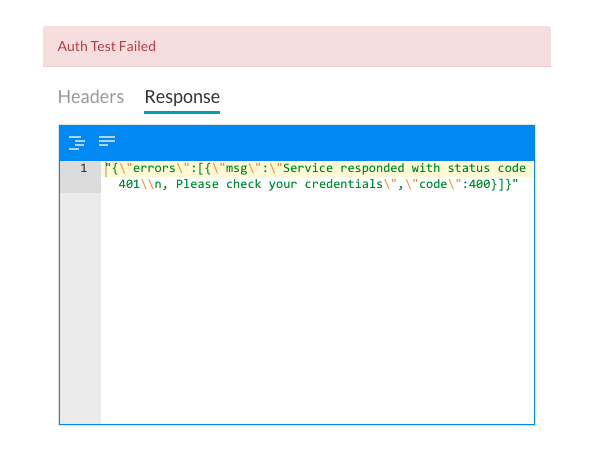
APIキーは、識別のためのユニークな識別子とシークレットトークンの両方の役割を果たすことができ、関連するAPIへのアクセス権利のセットを提供するための承認も可能です。エンドユーザーにアクセスのためのユーザー名とパスワードの両方をプロンプトする代わりに、ボットを調整する際にはAPIキーのみを要求されます。APIキー認証タイプを使用するには、まずは必ずウェブアプリケーションにアカウントを登録し、次にKore.ai認証メカニズムの設定を調整するためのそのアプリケーションのAPIキーを生成してください。ボットに認証を定義するには、以下の手順に従います。
テナントを定義する
必要に応じて、サブドメインセクションで、ウェブアプリケーションにベースURLやユーザーインターフェイスがURLにテナント名を使用する場合、はいを選択してください。例えば、koreは、www.kore.someCompany.comとしてテナントを使用したウェブサービスのテナント組織です。
認証フィールドの追加
デフォルトでは、認証フィルドとはボットリクエストのメッセージのヘッダーの一部として調整されたものです。ボットのリクエストに追加の認証フィールドが必要、または想定される認証がヘッダーの一部ではない場合(例:ソーシャルセキュリティ番号やPINなど)、認証フィールドの追加をクリックして下図の通りにフィールドを定義します。 
- フィールドタイプフィルドに、以下のうちの一つを選択することができます: 必須のボットリクエストメッセージの位置および認証フィルドのタイプの次第です。
- ヘッダー – ボットは認証フィールドをリクエストのヘッダーの一部として求めます。
- ペイロード – ボットは認証フィールドをリクエスト本体のコンテンツの一部として求めます。
- クエリー文字列―ボットは認証フィールドをリクエストのボディにあるクエリー として予想します。
- パースパラメータ(PathParam)―認証フィールドをURLパースリクエストの一部として予想されるボット。
- フィールドキーフィールドに、選択済のフィールドタイプフィールド名を入力してください。
- フィールド値フィールドに、フィールドキーの指定された値を入力してください。
- 追加をクリックします。新規の認証フィールドは認証フィールドのセクションに追加されました。
認証フィールドを追加する場合、認証フィールドセクションの追加をクリックしてください。
IDPフォームフィールドの追加
デフォルトのユーザー名とパスワードのフィールドがご需要を満たしていない場合、認証フォームのフィールドを追加することで、エンドユーザーに表示される新しいフィールドを追加することができます。認証フォームにフィールドを追加する場合、IDPフォームフィールドセクションで追加をクリックします。以下のテーブルは認証IDPフォームフィルドの定義に使用するフィルドの説明です。
| フィールド名 | 説明 |
|---|---|
| フィールド タイトル | 認証ダイアログでエンドユーザー表示するフィールド名を指定します。 |
| フィールドキー | この値は認証サービスにエンドユーザーが入力する値を示します。 |
| ヘルプのヒント | フィールドに表示されるヘルプ文字はフィールドに入力すべくものを説明しています。 |
| フィールドタイプ |
上級オプションと選択した場合、エンドユーザーインターフェイスに表示されるフィールドのタイプを指定して、ユーザー入力の割り当てたフィールドキー値として収集します、以下のうちの一つ:
|
| 必須 | 上級オプションと選択した場合、エンドユーザーは必ずこのフィールドを定義して認証を完成してください。 |
| データタイプ | 上級オプションと選択した場合、エンドユーザーからの入力と予想するデータタイプを指定してください。例えば、文字列。 |
| 可視性 | [詳細オプション] を選択した場合、認証フィールドを表示、非表示、または読み取り専用のいずれにするかを指定します。 |
コネクタを使用してアクセス
コネクタでアクセスのセクションで、はいを選択するとKore.aiコネクタエイジェントでKore.aiボットへのアクセスをできるようにします。もしご使用のドメインは定義済の活動的なKore.ai コネクタではないの場合、警告メッセージは表示され、ボットのアドミンコンソールのシステムアドミニストレータに連絡します。詳細については、ボット管理コンソールのドキュメントのKore.aiコネクタの使用をご確認ください。保存をクリックして保存認証を保存して新規認証メカニズムのダイアログを閉めます。
認証のテスト
認証を保存した後、認証プロファイルページからテストをクリックすると、認証の定義をテストすることができます。テストをクリックすると、テスト認証ダイアログが表示されます。 テスト認証の調整―APIキー
テスト認証の調整―APIキー
- 認証チェックURLフィールドに、実証やURLをテスト認証調整に入力してください。
- ボットはサブドメインを使用する場合、テンナンシーフィールドは表示されて、必ずテナントを指定してください。
- [API キー] フィールドでアプリケーションの API キーを入力します。
- URL として求めるコンテンツ タイプは、 [コンテンツ タイプ] フィールドで選択します。
- URLのテストの場合、方法フィールドはリードオンリーそしてGETと設定されました。
- テストをクリックすると認証テストを開始します。
認証の検証が完了すると、次の図のようにテスト認証のダイアログが閉じられ、成功または失敗の検証結果がテスト認証ボタンの右横に表示されます。認証失敗の場合、下記の図の通りに、認証テスト失敗のメッセージはヘッダーおよび応答のタブとともに表示します。 
An API key can act as both a unique identifier and a secret token for identification as well as authorization to provide a set of access rights on the associated API. Instead of prompting the end-user for both a username and password for access, the user is prompted only for an API key when configuring the Bot.
To use the API Key Authorization Type, you must first register an account with the web application and then generate an API Key for that application to configure the settings for the Kore.ai authorization mechanism.
To define Authorization for your bot, follow these steps:
- Open the bot for which you want to configure an Authorization profile.
- Select the Build tab from the top menu.
- From the left menus, click Configurations -> Authorization Profile
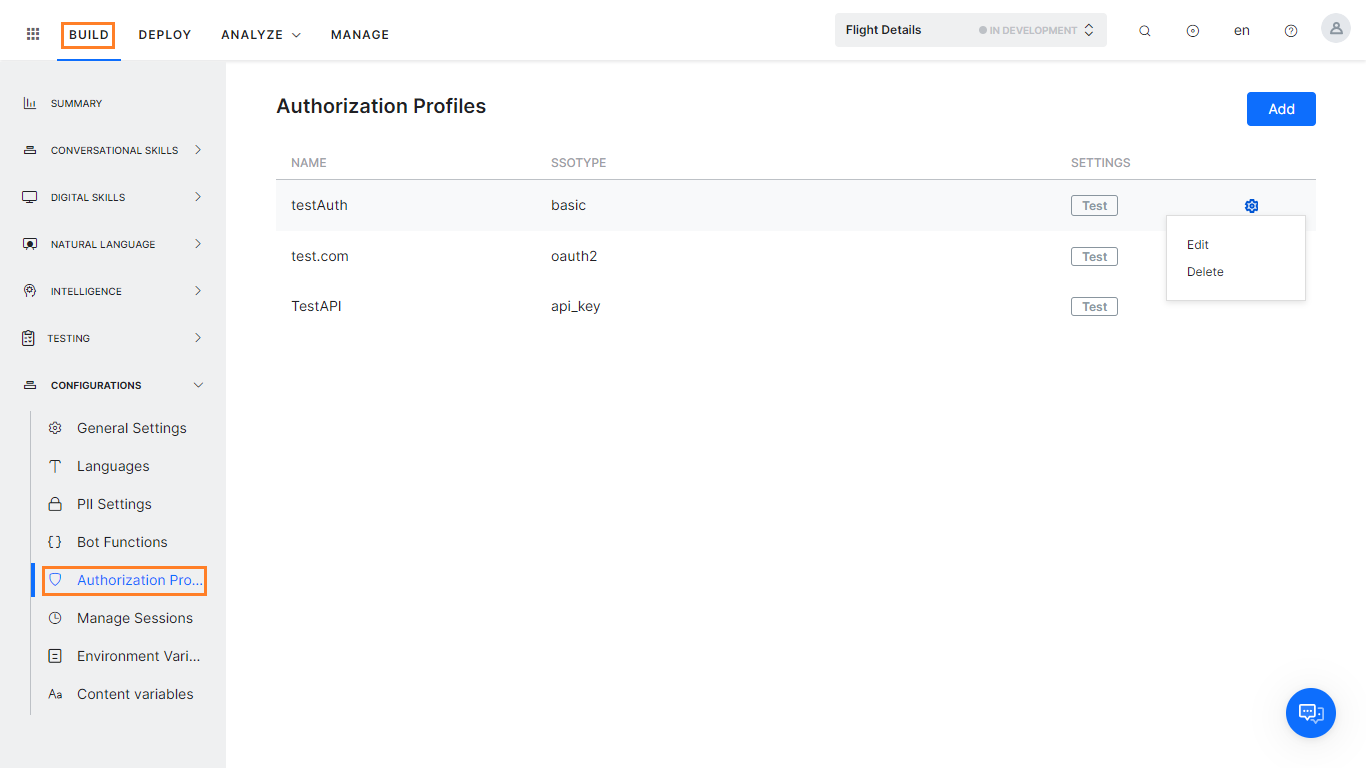
- Click Add. The New Authorization Mechanism dialog opens.
- In the Authorization Type drop-down list, select Api Key.
- The following illustration shows the fields to define for the API Key Authorization Type.
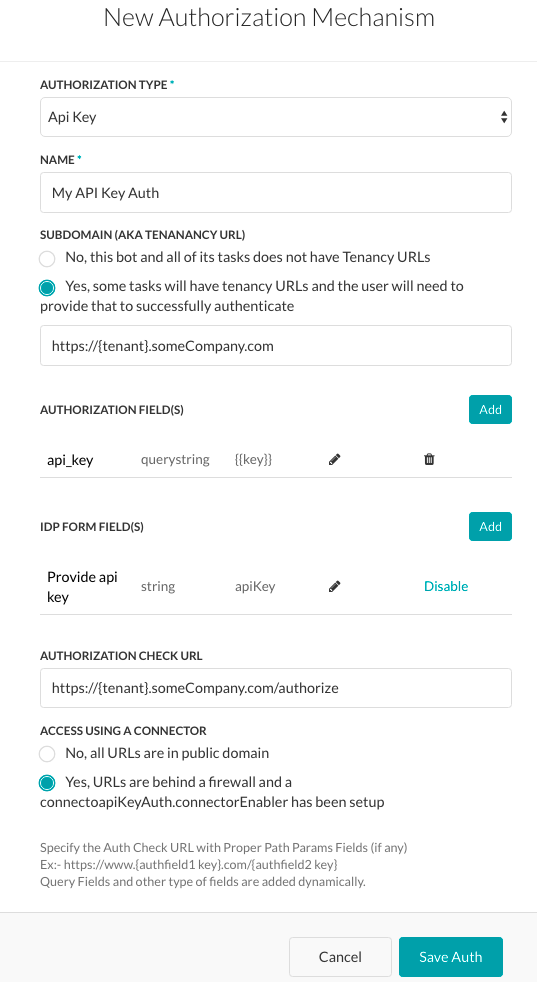
Defining Tenancy
If required, in the Subdomain section, select Yes if the base URL for a web application or user interface the uses a tenant name in the URL. For example, kore is the tenant organization for a web service using tenants at www.kore.someCompany.com.
Adding Authorization Fields
By default, authorization fields are configured as part of the header of the Bot request message. If your Bot request requires additional authorization fields or the expected authorization is not part of the header, for example, social security number or PIN, click Add in the Authorization Fields section and then define the fields as shown in the following illustration.

- In the Field Type field, you can select one of the following depending on where in the Bot request message and the type of authorization fields that are required.
- Header – The Bot expects the authorization fields as part of the header of the request.
- Payload – The Bot expects the authorization fields as part of the content of the body of the request.
- Query String – The Bot expects the authorization fields as a query in the body of the request.
- Path Param – The Bot expects the authorization fields as part of the URL path for the request.
- In the Field Key field, enter the name of the field for the selected Field Type.
- In the Field Value field, enter the value for the Field Key specified.
- Click Add. The new authorization field is added in the Authorization Fields section.
To add additional authorization fields, click Add in the Authorization Fields section.
Adding IDP Form Fields
If the default username and password fields do not meet your needs, you can add new fields displayed to the end-user by adding authorization IDP form fields. To add fields on the authorization form, click Add in the IDP Form Fields section.
The following table describes the fields used to define an authorization IDP form field.
| FIELD NAME | DESCRIPTION |
|---|---|
| Title of Field | Specify the name of the field displayed to the end-user in the authentication dialog. |
| Field Key | The value represents the end-user input value to the authenticating service. |
| Help Hint | The help text displayed in the field to describe what should be entered into the field. |
| Field Type | When Advanced Options is selected, specify the type of field displayed in the end-user interface to collect the user input assigned as the value for the Field Key, one of:
|
| Mandatory | When Advanced Options is selected, select if the end-user must define this field to complete authentication. |
| Data Type | When Advanced Options is selected, specify the type of data expected as input from the end-user, for example, String. |
| Visibility | When Advanced Options is selected, specify if the authentication field should be visible, hidden, or displayed as read-only. |
Authorization Check URL
In the Authorization Check URL field, optionally define a URL that can be used to test the authentication settings from Bot Builder before you deploy the Bot with the authorization mechanism. You can use dynamic fields, path parameter fields, query fields, and so forth, to define the test URL, for example,
https://kore.someCompany.com/sap/opu/odata/sap/{{authfield1}}/?$format=json
Access Using a Connector
In the Access Using a Connector section, select Yes to enable access for Kore.ai Bots using the Kore.ai Connector agent. If your domain does not have any active Kore.ai Connectors defined, a warning message is displayed to contact the Bots Admin Console system, administrator. For more information, see Using the Kore.ai Connector in the Bots Admin Console documentation.
Click Save to save the authorization settings and close the New Authorization Mechanism dialog.
Testing the Authorization
After you save the authentication, you can test your authorization definition when you click Test from the Authorization Profile page.
When you click Test, the Test Authorization dialog is displayed.

To configure the Test Authorization – API Key
- In the Auth Check URL field, verify or enter the URL to test the authentication configuration.
- If your bot uses subdomains, the Tenancy field is displayed and you must specify the tenant.
- Enter the API key for the application in the API Key field.
- Select the content type expected for the URL in the Content-Type field.
- For testing the URL, the Method field is read-only and set to GET.
- Click Test to begin the authorization test.
When the validation of authentication is complete, the Test Authorization dialog is closed and the results of the validation, either success or failure, is displayed to the immediate right of the Test Authorization button. If the authorization fails, the Auth Test Failed message is displayed along with the Headers and Response tabs as shown in the following illustration.

